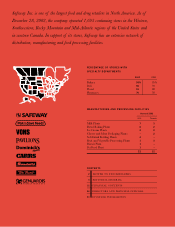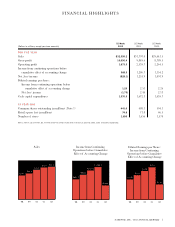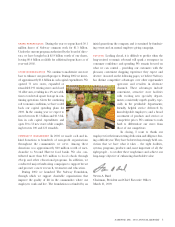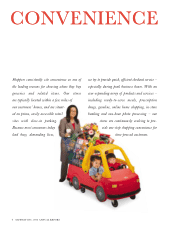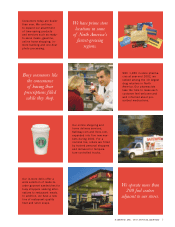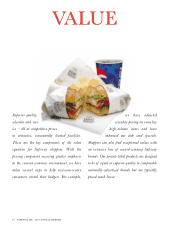Safeway 2002 Annual Report Download - page 4
Download and view the complete annual report
Please find page 4 of the 2002 Safeway annual report below. You can navigate through the pages in the report by either clicking on the pages listed below, or by using the keyword search tool below to find specific information within the annual report.
2SAFEWAY INC. 2002 ANNUAL REPORT
TO OUR STOCKHOLDERS
After a decade of steady growth, Safeway had a disap-
pointing year in 2002. While we recorded modest total
sales gains in continuing operations, certain operational
issues and the soft economy had a negative effect on our
same-store sales and profitability. Reported results were
also adversely affected by significant non-cash charges.
Our results are discussed below.
NET RESULTS We incurred a net loss of $828.1 million
($1.75 per share) in 2002 compared to net income of
$1,253.9 million ($2.44 per share) in
2001. These results reflect negative
impacts of $2,100.8 million ($4.43 per
share) in 2002, of which $1,988.0 mil-
lion was due to the impairment of
goodwill, and $32.8 million ($0.07 per
share) in 2001 as a result of the follow-
ing factors:
■■ In 2002 we adopted Statement of
Financial Accounting Standards No.
142, which eliminated goodwill amorti-
zation. The initial effect of adopting
SFAS No. 142 was a non-cash charge
of $700 million ($1.48 per share) in the first quarter of
2002, which is recorded as a cumulative effect of a change in
accounting principle. SFAS No. 142 also requires an annual
review for impairment, which we completed in the fourth
quarter of 2002, resulting in two additional non-cash
charges: $704.2 million ($1.48 per share) for Randall’s, which
is recorded as a component of operating income, and $583.8
million for Dominick’s, which is recorded as a component of
discontinued operations. These charges reflect declining val-
uation multiples in the retail grocery industry and operating
performance at these acquired companies. Results for 2001
include a goodwill amortization charge of $101.0 million
($0.20 per share) recorded in continuing operations.
■■We recently decided to sell Dominick’s and leave the
Chicago market. The total loss from discontinued Dominick’s
store operations in 2002, including the impairment charge
noted above, was $696.6 million ($1.47 per share). The loss
from discontinued Dominick’s store operations in 2001 was
$32.8 million ($0.07 per share).
SALES Total sales in 2002 rose 2% to $32.4 billion, pri-
marily due to new store openings. Comparable-store sales
declined 0.6%, while identical-store sales (which exclude
replacement stores) were down 1.2%.
Sales were negatively affected in the
first half of the year by shrink-reduc-
tion efforts and by transitional issues
associated with the centralization of
marketing functions. Continued soft-
ness in the economy also had a
dampening effect on sales through-
out the year.
GROSS PROFIT Gross profit increased
18 basis points to 31.16% of sales,
even though we reinvested a portion
of our cost savings into pricing and promotion.
OPERATING AND ADMINISTRATIVE EXPENSE Operating and
administrative expense rose 114 basis points to 23.82% of
sales, due primarily to increases in employee benefit costs,
real estate occupancy costs and pension expense as well
as soft sales.
INTEREST EXPENSE Interest expense was up slightly, to
$368.6 million in 2002 from $366.1 million in 2001. The
increase was due to higher average borrowings primarily
from debt incurred to finance the repurchase of Safeway
stock, partially offset by lower interest rates in 2002.
We continue to
modernize our store
base to enhance our
growth prospects.


